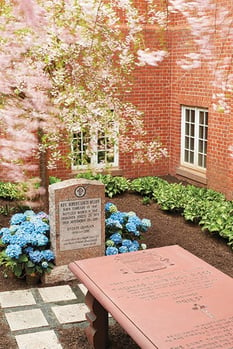
In between the Chapel and the Golden Center is an outside sunken courtyard, accessible by steps from the Golden Center, or the lower door from the Chapel. There are two trees in the courtyard — and often flowers in the spring and summer. It is a special place, this space in between two sacred spaces.
The space in between the Chapel and the Golden Center is also the burial place of Reverend T. Lawrason Riggs '10, the first Chaplain and founder of Saint Thomas More Chapel. Fr. Riggs died at his home in New Haven on April 26, 1943. It was Father Riggs’s wish to be buried at STM. Originally, the plan was to build a crypt below the Lady Chapel. That, however, had some obstacles. There were residences all around the Chapel and at that time, there was a Connecticut law that prohibited burials within 350 feet of any place of residence. In order to bury Fr. Riggs there, the Saint Thomas More Corporation asked the State for a special act. The Connecticut Senate and House of Representatives passed “an Act authorizing the burial of Reverend T. Lawrason Riggs. Late of New Haven, in the basement of the St. Thomas More Chapel, Park Street, New Haven” on May 5, 1943.1 In the meantime, Fr. Riggs had been buried in the Priest’s Circle at St. Lawrence Cemetery in West Haven.
The Saint Thomas More Corporation Board of Trustees had architect William Douglas submit drawings for the design of the vault and crypt at its meeting on May 24, 1943. “It was the unanimous desire of the Members and the Trustees that the remains of Father Riggs be brought from Saint Lawrence Cemetery, where they temporarily repose, as soon as the vault and crypt can be prepared to receive them.”2
At the next meeting of the Corporation on October 11, 1943, the trustees went to visit the Lady Chapel and the place in the cellar where the crypt would be built. The trustees were not sure this was the right place to honor Fr. Riggs. “The Trustees were of the opinion that the location in the cellar was unsuitable because of its proximity to the large entertainment hall and its remoteness for visitors who might wish to approach it devoutly.”3 They were also in favor of asking the executors of Fr. Riggs’s estate to pay for the reinterment, wherever it would be. They asked the architect to reconsider his plans and consider other alterations to present to the trustees.
The Board eventually decided that the Chapel grounds would be the best place for the grave of Fr. Riggs. But the special act passed by the legislature only gave permission to bury him in the basement. On October 2, 1944, the “Trustees informally reaffirmed their approval of the plan to bury Father Riggs outside the Chapel” and directed the President of the Board to go back to the legislature.4 The legislature complied with their request. A special act was passed on April 23, 1945, “authorizing the burial of Reverend T. Lawrason Riggs, formerly of New Haven, in a plot in the grounds surrounding and appurtenant to the St. Thomas More Chapel, Park Street, New Haven.”5 At the next board meeting, the president was authorized to enter into a contract with William Douglas, to carry out plans for the grave.
Fr. Riggs would soon be buried in the yard behind what is now known as the Riggs Study. Provisions were made for landscaping and building a wall. His three relatives who inherited his estate each made a gift of $500 for the landscaping. Fr. Riggs was now home, buried beside the Chapel he conceived and built.
His beautiful table tomb is now enshrined in the space between the Chapel and the Golden Center. The stone is engraved with Father Riggs’s history. Its surface contains a quote that makes you wish you knew the man:
“Rich in faith and grace he gave unstinted devotion to his church and with his fellow men he gladly shared his gifts of a beguiling wit, an acute intellect and an affectionate heart. Just, generous and wise, he spent his days in the unfaltering service of God and of mankind.”

This quote reminds me of our own beloved Father Bob Beloin, our chaplain of twenty-five years, who is the next person to grace the space in between. Fr. Bob was also a conceiver of ideas and a builder. He saw the need for a full Catholic Center at Yale, where students could share faith and fellowship. He raised money to have the Thomas E. Golden, Jr. Center built, and his vision of a thriving Catholic intellectual center lives in all of us today. His gifts were similar to those of Father Riggs— intellect, humor, wisdom and generosity. He taught us about abundant life, in all its aspects. His burial in the courtyard space with Fr. Riggs is right and fitting. They are both surrounded not just by the buildings they built, but by the Yale students and community members who were and are their flock, and by the explosion of Catholic life at Yale. It is wonderful to have them there, reminding us of the community which they created while watching over us all.
1 Special Acts of the Connecticut Legislature, 1943, 359. Senate Bill No. 821. Page 250
2 St. Thomas More Corporation Record Book, page 67 (May 24, 1943)
3 Ibid. page 81 (October 11, 1943)
4 Ibid. page 85 (October 2, 1944)
5 Special Acts of the Connecticut Legislature, 1945. 106. Senate Bill No. 814. Page 554